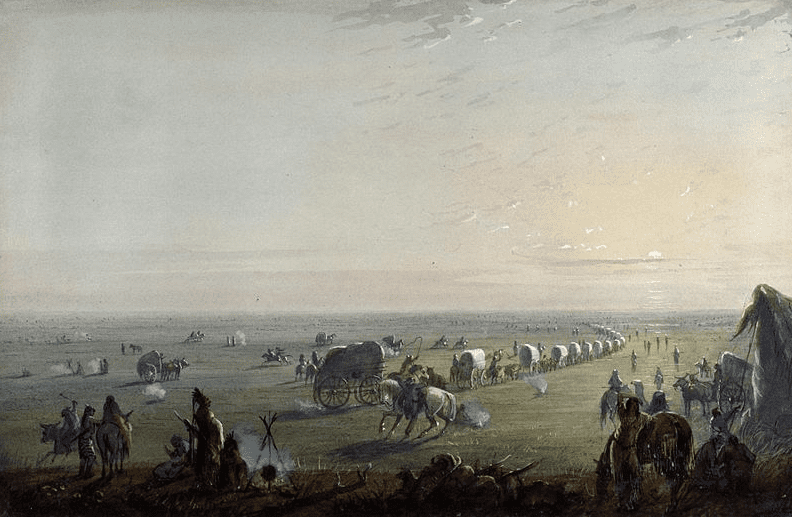Ever wondered whether your ancestors were pioneers who blazed their way toward the Pacific during the Westward Expansion? The history of the United States is brimming with stories of families who left their entire lives behind to forge a new independence in the West. Even so, many people have no idea how their family arrived at their place of birth.

If you live west of the Mississippi territory, chances are your family were such trailblazers at one time, part of the “Manifest Destiny” movement in American history. Thanks to online census data, it’s never been easier to track the path of your ancestors and learn more about your family’s history and their settlement out West.
What Was the Westward Expansion?
The United States experienced a major shift during the 19th century, as thousands of people embarked on their own unique journey west. Some were simply looking for a better life or a new opportunity, while others were searching for gold or fleeing religious persecution. Each individual expedition contributed to the spread of people across the continent’s plains, leading to the America we know today.
Why People Moved West
When looking at the Westward Expansion timeline, it is easy to pinpoint a start. The United States completed the Louisiana Purchase from France in 1803, acquiring much of the modern Midwestern and Rocky Mountain states, along with a big part of Louisiana and Arkansas. This led to thousands of Americans moving to regions where they could become landowners, starting new lives away from the bustling Eastern cities.
The Lewis and Clark Expedition, from May 1804 to September 1806, was the spark that led to the development of trails spanning the nation.
While there were various trails that pioneers used on the Westward Expansion, three are especially significant: the Oregon Trail, the Mormon Trail, and the Santa Fe Trail.
The California Gold Rush of 1849 initiated an expanded migration west, as thousands more Americans left their homes seeking riches, wealth, and economic opportunities. Over the remainder of the century, the entire western part of the continent would slowly develop into what is today the continental United States.
Using Census Data to Uncover Your Family’s History
There are several mechanisms available that you can use to uncover your own family’s story during the Westward Expansion. Luckily, the United States government has kept records throughout its history that can help you with your search. One of the most useful record-keepers is census data.
The National Archives Census Data
The National Archives is an excellent resource to begin tracing your family history. This collection lets you search through several different types of records to help you learn about your family’s story:
- United States Census Records – Up until 1840, census information was limited to the male head of the family. However, after that time, the U.S. government began tracking more detailed information of all members of a household. You can utilize the census to see where members of your family lived over the years, and track their progress west.
- Military Records – If members of your family were in the military, these records will contain a host of information about those individuals. These records go as far back as the Revolutionary War, so it will definitely shed light on where your family members lived over time.
- Land Records – The National Archives also retains millions of land ownership records through the Bureau of Land Management. The majority of these records contain information about land that was purchased from the United States, which was most of the land bought by pioneers and settlers during the Westward Expansion.
- Immigration and Naturalization Records – You can also search through naturalization records to see your family’s immigration history. While these records may not specifically apply to the Westward Expansion, they can help you begin your search by determining where your family started life in the United States.
State Archives
Individual state archives can also be incredibly useful in telling your family’s story. Not only has each state conducted its own census, but they also kept pioneer records. These records are still available today and can specifically determine whether your family member was a pioneer. States also keep records of the Native American tribes and their population, which may be helpful in uncovering even more information about your family’s genealogy.
Other Census Data
It is also possible to look through specific records or U.S. Census Records on pioneer history through genealogy sites such as GenealogyBank. These companies and organizations have accrued massive amounts of documents tracking the historical path of migration during the Westward Expansion. They may even be able to provide insight on the specific route that your family took and provide information on why they moved west in the first place.
How You Fit into History
The Westward Expansion saw thousands of Americans leave their homes in search of a more prosperous life in the West. The sprawling cities that make up the Western United States today are a direct result of this movement, and everyone who currently lives in the West is a part of this story.
There is a multitude of information available in determining how you fit into the history of the Westward Expansion, so begin your search today to find out who you really are!
Sources:
- Encyclopaedia Britannica: Louisiana Purchase.
- Encyclopaedia Britannica: Westward Movement.
- National Archives: Resources for Genealogists.
- Weebly.com: Westward Expansion.
- GenealogyBank
Related Articles:

What a great resource! Thank you!
We’re glad you found this article helpful, Curtis. Thanks for writing us!
Also check out http://www.paper-trail.org. It is a database of over 2,000 indexed trail diaries. People can search by name to see if their ancestor kept a diary or are mentioned in another diary. The database also tells you which library holds the library. Finally, check out http://www.octa-journals.org and http://www.gateway-octa.org for about 600 digitized trail diaries.
Thanks for these valuable tips, Travis.